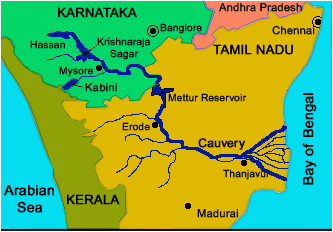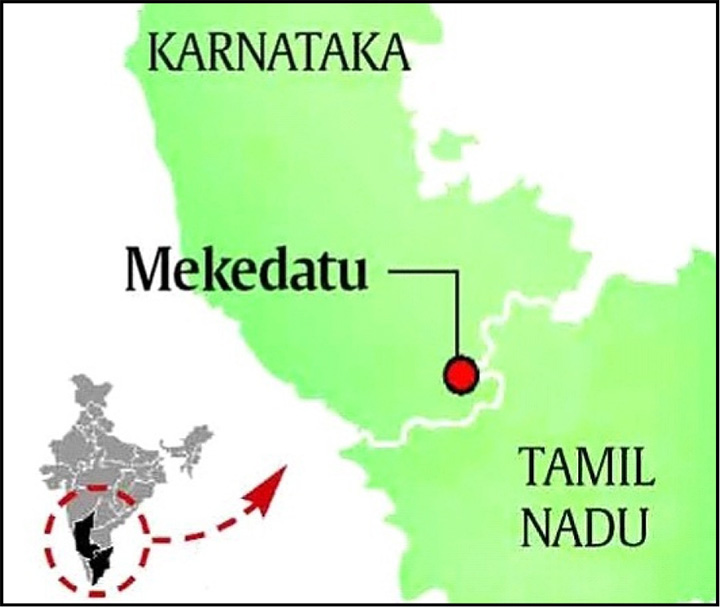Governance
Mekedatu Project: River Cauvery
- 28 May 2021
- 7 min read
Why in News
Recently, the Karnataka government has decided to challenge before the National Green Tribunal (NGT) its decision to appoint a joint committee.
- The joint committee is supposed to look into allegations of unauthorised construction activity taking place in Mekedatu, where Karnataka had proposed to construct a dam across the Cauvery.
- Mekedatu, meaning goat’s leap, is a deep gorge situated at the confluence of the rivers Cauvery and its tributary Arkavathi.
Key Points
- Mekedatu Project:
- The Rs. 9,000 crore project aims to store and supply water for drinking purposes for the Bengaluru city. Around 400 megawatts (MW) of power is also proposed to be generated through the project.
- It was first approved by the Karnataka state government in 2017.
- It received approval from the erstwhile Ministry of Water Resources for the detailed project report and is awaiting approval from the Ministry of Environment, Forest and Climate Change (MoEFCC).
- The approval from MoEFCC is crucial because 63% of the forest area of the Cauvery Wildlife Sanctuary will be submerged.
- In 2018, Tamil Nadu approached the Supreme Court (SC) against the project even if Karnataka had held that it would not affect the flow of water to Tamil Nadu.
- In June 2020, during the Cauvery Water Management Authority’s meeting, Tamil Nadu reiterated its opposition to the project.
- Reasons for Opposition by Tamil Nadu:
- Tamil Nadu is opposed to any project being proposed in the upper riparian unless it was approved by the SC.
- Karnataka has no right to construct any reservoir on an inter-state river without the consent of the lower riparian state i.e. Tamil Nadu in this case.
- The project is against the final order of the Cauvery Water Disputes Tribunal (CWDT) in which the SC held that no state can claim exclusive ownership or assert rights to deprive other states of the waters of inter-state rivers.
- The CWDT and the SC have found that the existing storage facilities available in the Cauvery basin were adequate for storing and distributing water so Karnataka’s proposal is ex-facie (on the face of it) untenable and should be rejected outright.
- It has also held that the reservoir is not just for drinking water alone, but to increase the extent of irrigation, which is in clear violation of the Cauvery Water Disputes Award.
Cauvery River Dispute
- River Cauvery (Kaveri):
- It is known as ‘Ponni’ in Tamil also known as Ganga of the south, and it is the fourth largest river of southern India.
- It is a sacred river of southern India. It rises on Brahmagiri Hill of the Western Ghats in southwestern Karnataka state, flows in a southeasterly direction through the states of Karnataka and Tamil Nadu, and descends the Eastern Ghats in a series of great falls and drains into Bay of Bengal through Pondicherry.
- Some of its tributaries are Arkavathi, Hemavathi, Lakshmana Theertha, Shimsa, Kabini and Harangi.
- The Dispute:
- Historical Background:
- As the river originates in Karnataka, flows through Tamil Nadu with major tributaries coming from Kerala and drains into Bay of Bengal through Pondicherry the dispute therefore involves 3 states and one Union Territory.
- The genesis of the dispute is 150 years old and dates back to the two agreements of arbitration in 1892 and 1924 between the then Madras presidency and Mysore.
- It entailed the principle that the upper riparian state must obtain consent of lower riparian state for any construction activity viz. reservoir on the river Cauvery.
- Recent Developments:
- From 1974, Karnataka started diverting water into its four newly made reservoirs, without the consent of Tamil Nadu resulting in a dispute.
- To resolve the matter, the CWDT was established in 1990 which took 17 years to arrive at the final order (2007) on how Cauvery water should be shared between the 4 riparian states in normal rainfall conditions.
- In distress years, a pro-rata basis shall be used, it instructed. The government again took 6 year and notified the order in 2013.
- This was challenged in SC which directed Karnataka to release 12000 cusecs of water to Tamil Nadu prompting protests in the State.
- The final verdict of the SC came in 2018 where it declared the Cauvery a national asset and largely upheld the water-sharing arrangements finalised by the CWDT and also reduced the allocation of water from Karnataka to Tamil Nadu.
- As per the SC, Karnataka would get 284.75 thousand million cubic feet (tmcft), Tamil Nadu 404.25 tmcft, Kerala 30 tmcft and Puducherry 7 tmcft.
- It also directed the Centre to notify the Cauvery Management Scheme. The central government notified the ‘Cauvery Water Management Scheme’ in June 2018, constituting the ‘Cauvery Water Management Authority’ and the ‘Cauvery Water Regulation Committee’.
- Historical Background:
Way Forward
- The states need to shed the regional approach as the solution lies in cooperation and coordination, not in conflict. The planning must be done at the basin level to make the solution sustainable and ecologically viable.
- In the long term, there is a need to recharge the river through afforestation, river linking, etc and increased focus is needed on increasing water use efficiency viz. micro irrigation, awareness in people to prudently use water and water smart strategies.





